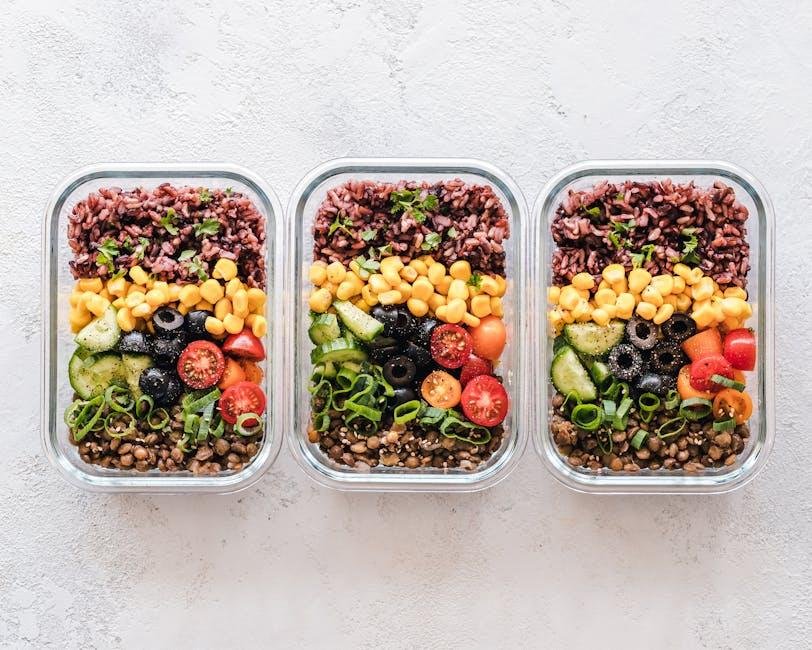Meal prepping has become a popular strategy for those looking to maintain a balanced diet while saving time and reducing stress during busy weekdays. By planning and preparing meals in advance, you can ensure nutritional success every week, making it easier to stick to your health goals without feeling overwhelmed. In this article, we’ll explore practical meal prep tips that can help you streamline your weekly routine, maximize nutrient intake, and enjoy delicious, wholesome meals with minimal effort. Whether you’re a beginner or looking to refine your approach, these tips will set you up for consistent, healthy eating habits.
Table of Contents
- Choosing Balanced Ingredients for Optimal Nutrition
- Effective Portion Control Strategies for Daily Meals
- Batch Cooking Techniques to Save Time and Reduce Waste
- Storing and Reheating Tips to Maintain Freshness and Flavor
- To Wrap It Up
Choosing Balanced Ingredients for Optimal Nutrition
When aiming for meal prep that fuels your body efficiently, it’s essential to blend a variety of nutrient-dense ingredients in every dish. Start by focusing on whole foods like lean proteins, whole grains, and fresh vegetables. Incorporating a spectrum of colors on your plate ensures you receive a broad range of vitamins and antioxidants, each playing a unique role in maintaining your health. For example, leafy greens provide iron and fiber, while orange and red vegetables deliver beta-carotene and vitamin C. This thoughtful balance helps to keep your energy levels stable throughout the day and supports overall wellness.
Don’t forget to include healthy fats and fiber-rich components to maximize nutrient absorption and promote satiety. Ingredients like avocado, nuts, seeds, and legumes add creamy textures and pleasant flavors while supporting heart health and digestion. Here’s a quick checklist to guide your ingredient choices:
- Proteins: chicken, turkey, tofu, fish, beans
- Whole Grains: quinoa, brown rice, farro, oats
- Vegetables: spinach, bell peppers, broccoli, carrots
- Healthy Fats: olive oil, flaxseeds, almonds, avocado
- Herbs & Spices: turmeric, ginger, garlic, fresh basil
By thoughtfully combining these, you prepare meals that aren’t only satisfying but also optimize your nutrient intake every week.
Effective Portion Control Strategies for Daily Meals
Mastering portion control doesn’t mean sacrificing satisfaction. One simple yet powerful technique is to use smaller plates and bowls, which naturally encourages you to serve and consume less without feeling deprived. Additionally, pre-dividing your meals into single-serving containers during prep can help eliminate guesswork and prevent overeating. Incorporate a colorful variety of vegetables and lean proteins to make your meals feel fuller and more balanced while keeping portions in check. Remember, it’s about quality and balance, not just quantity.
Equally important is learning to listen to your body’s hunger cues instead of eating out of habit or boredom. Taking time to eat slowly and mindfully allows your brain to register fullness, reducing the risk of unintentional overeating. Keep a handy list of healthy snacks portioned out in advance, such as nuts or fruit slices, to manage hunger between meals without overindulging. By combining these strategies, you’ll stay on track with your nutritional goals while enjoying every bite.
- Use measuring cups or a food scale to get familiar with proper serving sizes.
- Fill half your plate with vegetables to bulk up meals with nutrient-dense foods.
- Pre-portion snacks in advance to avoid mindless munching.
- Stay hydrated, as thirst is often mistaken for hunger.
Batch Cooking Techniques to Save Time and Reduce Waste
Efficient batch cooking revolves around strategizing your meal components to maximize usage and minimize leftovers. Start by selecting ingredients that can be versatile across multiple dishes, such as grains, legumes, and roasted vegetables. Cooking these in larger quantities at once not only saves time but also reduces food waste by avoiding multiple trips to the kitchen throughout the week. Incorporate airtight containers or reusable silicone bags to store portions safely, allowing you to easily grab and reheat meals without sacrificing freshness.
Another effective approach is to utilize cooking appliances smartly to expedite preparation. For example, slow cookers and instant pots excel at making large batches of soups, stews, or proteins, freeing up stove space and your time. Additionally, consider chopping and prepping ingredients for different recipes in one go—such as dicing vegetables or marinating proteins—before storing them for quick assembly later. This level of organization ensures that you’re eating nutritiously while cutting down the stress and clutter that often accompany weekday meal prep.
- Double recipes to create ready-to-use portions.
- Repurpose leftovers by turning roasted veggies into stir-fry or frittatas.
- Label containers with contents and date to track freshness.
- Freeze individual servings for longer storage without quality loss.
Storing and Reheating Tips to Maintain Freshness and Flavor
To keep your meals tasting fresh and vibrant throughout the week, proper storage is essential. Use airtight containers made of glass or BPA-free plastic, which help preserve both flavor and texture. When portioning your meals, consider the type of ingredients used—storing leafy greens separately from dressings or sauces can prevent sogginess and maintain crispness. Label each container with the preparation date to stay organized and ensure you consume meals within optimal freshness windows. Additionally, freezing portions that won’t be eaten within three days can lock in nutrients and slow spoilage.
Reheating is equally important in preserving meal quality. For best results, gently rewarm dishes using a microwave-safe cover or opt for stovetop reheating with a splash of water or broth to retain moisture. Avoid overheating, which can degrade flavors and dry out proteins or grains. When reheating soups or stews, stirring midway helps distribute heat evenly. Pro tips include reheating only the portion you plan to eat immediately and adding fresh herbs or a squeeze of lemon to brighten the flavors post-warming, bringing your meals back to life with minimal effort.
To Wrap It Up
With these meal prep tips in your toolkit, staying on track with your nutrition goals becomes much more manageable. Remember, the key is consistency and finding a routine that fits your lifestyle. By dedicating a little time each week to plan and prepare your meals, you set yourself up for nutritional success and less stress around mealtime. Give these strategies a try, tweak them as needed, and enjoy the benefits of healthy, convenient eating every day.
Related Products
-
Sale!
OGX Renewing + Argan Oil of Morocco, Cold-Pressed …
Beauty Original price was: $10.69.$7.97Current price is: $7.97. -
Raise Them Well Mom Multi+ Daily Multivitamin for …
Mom $27.99 -
Sale!
Men’s Bomber Jacket Fashion Stylish Lightweight Wi…
Clothing Original price was: $39.99.$32.99Current price is: $32.99.







